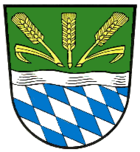District of Straubing
| coat of arms | Germany map | |
|---|---|---|

|
Coordinates: 48 ° 53 ' N , 12 ° 34' E |
|
| Basic data (as of 1972) | ||
| State : | Bavaria | |
| Administrative region : | Lower Bavaria | |
| Administrative headquarters : | Straubing | |
| Area : | 462.44 km 2 | |
| Residents: | 31,303 (May 27, 1970) | |
| Population density : | 68 inhabitants per km 2 | |
| License plate : | SR | |
| Circle key : | 09 2 47 | |
| Circle structure: | 46 municipalities | |
| District Administrator : | Anton Wild | |
| Location of the district of Straubing in Bavaria | ||
The district of Straubing belonged to the Bavarian administrative district of Lower Bavaria . Its former area is now largely in the Straubing-Bogen district .
geography
Important places
The largest towns were Aiterhofen , Rain , Steinach and Feldkirchen .
Neighboring areas
In 1972 the district bordered in a clockwise direction in the northeast on the districts of Bogen , Deggendorf , Landau an der Isar , Dingolfing , Mallersdorf and Regensburg .
The independent city of Straubing was an enclave in the middle of the district.
history
district Court
In 1803, in the course of the administrative restructuring of Bavaria, the Straubing Regional Court was established. After the founding of the Kingdom of Bavaria, this was added to the Regenkreis , whose capital was Straubing until 1810.
In 1809 the city of Straubing was spun off from the regional court district and raised to the status of a city in the immediate vicinity , but remained the administrative seat of the regional court.
In 1810 the Straubing Regional Court came to the Lower Danube District with the capital Passau.
In 1838 the Lower Danube District was renamed the District of Lower Bavaria from which the administrative district of the same name emerged .
District Office
The district office of Straubing followed in 1862 the area court of the older order of Straubing.
On the occasion of the reform of the layout of the Bavarian district offices, the Straubing district office received the municipality of Pittrich from the Regensburg district office on January 1, 1880.
district
On January 1, 1939, the designation district was introduced as everywhere else in the German Reich . So the district office became the district of Straubing.
In 1946 the district of Straubing was enlarged to include the communities of Kirchroth and Zeitldorn of the district of Regensburg.
On January 1, 1972, the district ceded the communities of Alburg , Hornstorf , Ittling and Kagers to the independent city of Straubing.
On July 1, 1972, the Straubing district was dissolved as part of the regional reform in Bavaria . Its communities were merged with some communities in the dissolved Mallersdorf district , some communities in the Regensburg district and with the dissolved district of Bogen (with the exception of the municipality of Bernried ) to form the new district of Straubing-Bogen .
Population development
| year | Residents | source |
|---|---|---|
| 1864 | 20,675 | |
| 1885 | 21,719 | |
| 1900 | 21,924 | |
| 1910 | 23,416 | |
| 1925 | 23,359 | |
| 1939 | 26,971 | |
| 1950 | 34,521 | |
| 1960 | 28,600 | |
| 1971 | 31,600 |
District administrators
1960: Josef Schmid
1970: Anton Wild, Atting
Communities
Before the start of the Bavarian regional reform, the Straubing district comprised 46 municipalities in the 1960s:
|
|
- The community of Riedling was incorporated into Oberpiebing on August 1, 1920 and the community of Pittrich to Kößnach on January 1, 1946.
License Plate
On July 1, 1956, the district was assigned the distinctive sign SR when the vehicle registration number that is still valid today was introduced . It is issued in the district of Straubing-Bogen and in the city of Straubing until today.
literature
- Josef Fischer (ed.): The district of Straubing. District Office Straubing, Straubing 1970.
Individual evidence
- ^ Wilhelm Volkert (ed.): Handbook of Bavarian offices, communities and courts 1799–1980 . CH Beck, Munich 1983, ISBN 3-406-09669-7 , p. 577 .
- ^ Wilhelm Volkert (ed.): Handbook of Bavarian offices, communities and courts 1799–1980 . CH Beck, Munich 1983, ISBN 3-406-09669-7 , p. 97 .
- ^ Federal Statistical Office (ed.): Historical municipality directory for the Federal Republic of Germany. Name, border and key number changes in municipalities, counties and administrative districts from May 27, 1970 to December 31, 1982 . W. Kohlhammer, Stuttgart / Mainz 1983, ISBN 3-17-003263-1 , p. 624 .
- ^ Ordinance on the reorganization of Bavaria into rural districts and independent cities of December 27, 1971
- ^ Eugen Hartmann: Statistics of the Kingdom of Bavaria . Ed .: Royal Bavarian Statistical Bureau. Munich 1866, population figures of the district offices 1864 ( digitized version ).
- ↑ Royal Bavarian Statistical Bureau (ed.): Localities directory of the Kingdom of Bavaria . Munich 1888, population figures of the district offices 1885 ( digitized ).
- ↑ a b www.gemeindeververzeichnis.de
- ^ Localities directory for the Free State of Bavaria, based on the census of June 16, 1925
- ↑ Statistical Yearbook for the German Reich 1940
- ↑ Statistical Yearbook for the Federal Republic of Germany 1952
- ↑ Statistical Yearbook for the Federal Republic of Germany 1961
- ↑ Statistical Yearbook for the Federal Republic of Germany 1973
- ^ Official register of places for Bavaria 1964



